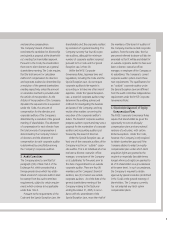Canon 2004 Annual Report Download - page 21
Download and view the complete annual report
Please find page 21 of the 2004 Canon annual report below. You can navigate through the pages in the report by either clicking on the pages listed below, or by using the keyword search tool below to find specific information within the annual report.
19
core element in its reforms. This method
helps to save resources and energy,
reduces carbon dioxide gas emissions and
waste, and lowers costs. The end result is
a contribution to profitability.
Looking at waste measures first, the
pursuit of company-wide reductions in
costs and the introduction of technologies
to sort collected items, and to disassemble
and recycle them into valuable goods all
contribute to reducing waste output. At
present, 39 of Canon’s production sites in
Japan and nine sites outside Japan have
achieved the goal of zero landfill waste.
Even greater efforts are being made to
reduce waste at the other plants and at
marketing subsidiaries and affiliates.
Canon is moving forward with water
conservation and recycling measures.
In 2004, Canon recycled 930,000 m3
of water. When we established Oita
Canon Materials Inc. in 1999, we made
its plant a zero wastewater facility by
installing a completely closed recycling
system that uses no outside water sources
other than rain. Canon also introduced
new closed wastewater processing systems
at the Utsunomiya Plant (Japan) and
Canon Zhuhai, Inc. (China), and the use of
Ultra-Pure Water Recycling Systems at
our semiconductor plants.
Sales and Logistics
Canon has been reducing carbon dioxide
emissions in its logistics operations and,
by developing a highly efficient system
for distribution and delivery, is working to
reduce the burden on the environment.
Canon is also working in other areas to
preserve the environment; for example,
through the introduction of low-emission
vehicles and by paying close attention to
product packaging. Moreover, Canon is
aggressively implementing a modal shift,
or a switch from truck transport to ship
or rail transport. In 2004, Canon Inc.
teamed up with a transport firm and
a railway company in Japan to jointly
design a new railcar container that is
similar in measurement to an ocean
container, with high storage capacity.
In the United States and Europe also,
Canon is implementing a modal shift
to use of rail transportation.
Products in Use
Canon has improved the energy efficiency
of its products even further with the
introduction of on-demand, energy-
efficient technology and other proprietary
technologies. As copying machines
and laser beam printers use the most
energy when they are in standby mode,
Canon has adopted two types of on-
demand, energy-efficient technologies
to reduce their energy consumption
while in this mode.
In on-demand, energy-efficient
technology, a ceramic heater localizes
the heating to a specific area through
a
fixing film during printing. Surplus
energy
consumption is avoided and
energy efficiency realized. IH fixing
technology, which employs an
electromagnetic induction heater,
Vision for 2010
Overriding Indicator: Factor 2
(Increase by at least a factor of 2.0 the ratio of net sales*1 to
life cycle CO2 emissions*2, using 2000 as the reference year)
*
1
Annual consolidated sales of the Canon Group.
*
2
The environmental burden from the business activity life cycle —the flow of business activities from production
of raw materials, to production and marketing by the Canon Group, use by the customer, and recycling /disposal
after use—is converted into total direct CO
2
emissions.
Canon developed a new closed recycling system for processing, purifying, and reusing water and introduced it in Zhuhai, China.
New railcar container designed jointly with a transport firm
and a railway company.
























